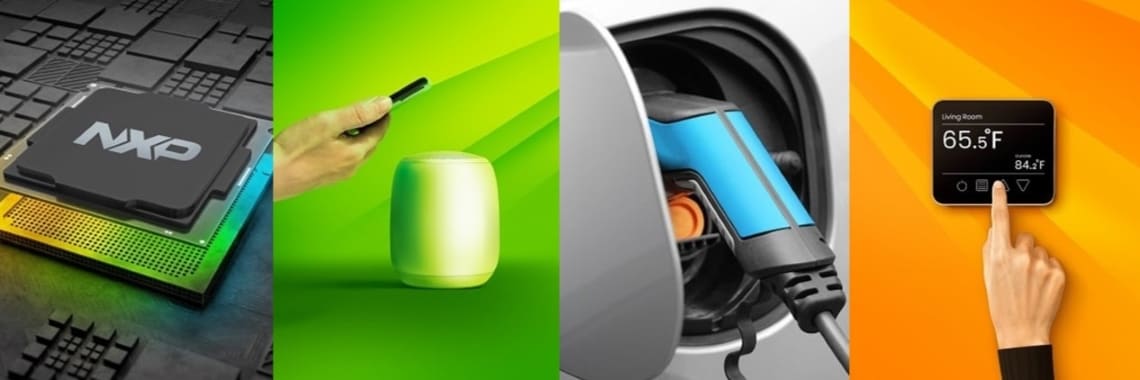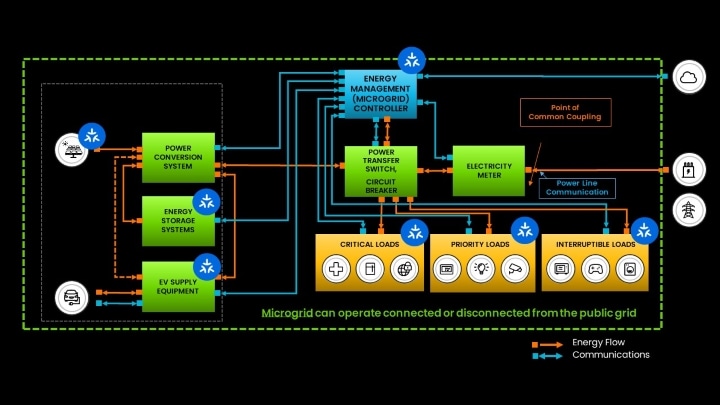As promised in last week’s Wireless Wednesday blog, we’re focusing on everything about Matter 1.4 this week.
Announced by the CSA on November 7th, Matter 1.4 has now been released and brings support for several important
areas, including
additional energy management device types and capabilities, home network infrastructure and enhanced
multi-admin. NXP
collaborates with companies across the industry in their efforts to build and launch their Matter compatible
portfolios—supporting them in the development and deployment stages as well as bringing their application
requirements and use
cases into the development of the Matter Standard.
NXP is excited and committed to each of these key areas introduced or enhanced by Matter 1.4 and is driving
forward with
numerous partners and customers to enable and implement these capabilities to further enhance the foundation
that Matter
provides to the autonomous home. As Matter continues to evolve, we at NXP think that the evolution of
capabilities and device
types supported up through Matter 1.4, along with planned improvements and expansions coming in Matter 1.5, will
have a
significant impact in driving increased adoption of Matter—thereby creating value and benefit to the end users
that was
previously unattainable. Three of these key areas of particular focus to NXP include:
Energy Management
At NXP, we believe the evolution from the smart home to a truly autonomous home cannot be attained without
energy intelligence and orchestration. With Matter 1.4, many of the most essential elements needed for energy
devices and
critical loads to work together in concert are now available. These elements of device-level energy management
control and
reporting provide the foundation for devices to operate on a local level (device to device) without dependence
on the cloud
and the complexities that introduces. NXP continues to collaborate with our partners to expand this foundation
in future
versions of Matter with more energy device type enhancements and capabilities to work with utilities and other
energy sources
involved.
Home Network Infrastructure
For consumers to have a straightforward path to creating a Matter based smart home environment
tailored to their preferences and needs, they must have the right infrastructure in their homes. Matter 1.4 adds
certifiable
support for Home Routers and Access Points (HRAP), which can be designed into new HRAP devices or upgraded into
HRAP devices
already installed in homes today. This will create more paths for seamless connectivity required for Matter.
Enhanced Multi-Admin
A valuable element Matter gives consumers is choice and flexibility in building out their smart home so
that they can make purchasing decisions based on capabilities and experiences instead of being tied to one specific
ecosystem
or brand. Starting in Matter 1.4 with expansions and improvements planned for Matter 1.5, Enhanced Multi-admin will make
this
experience simpler and much more powerful for the end user.
What's New in Matter 1.4:
Energy Management Device Types and Features
Home energy management is emerging as one of the top reasons driving consumers to adopt smart home devices,
according to recent
research from Parks Associates*. Not only do consumers want to know how much energy each device and appliance in
their home is
using, but they are looking to routines and automations to help them save energy and decrease their energy bills
without making
manual adjustments. With the new device types and features introduced in Matter 1.4, this future becomes
possible. In the Matter
1.3 update, we introduced energy reporting, enabling energy management use cases for large appliances and
electric vehicle
supply equipment. Matter 1.4 expands its energy management capabilities by adding support for new device types
like solar
panels, batteries, heat pumps and water heaters. These additions, along with improvements to the energy
management and
thermostat clusters, pave the way for smarter, more automated energy management within the home.
- New Device types: Solar Power, Batteries, Heat Pumps, Water Heaters
- Enhanced Device Types: EVSE, Thermostats
- Features: Device Energy Management and Mode
(source: Connectivity Standards Alliance
announcement)
NXP offers a wide range of solutions to build Matter devices. Learn more about Matter.
Network Infrastructure with Home Routers and Access Points (HRAP)
Devices such as home routers and modems, access points and set-top boxes can now be designed or upgraded to
provide more robust
support for Matter-based smart homes. Matter-certified HRAP devices provide the foundational infrastructure of
smart homes by
combining both a Wi-Fi access point and a Thread Border Router, ensuring these ubiquitous devices have the
necessary
infrastructure for Matter products using either of these technologies. HRAP devices also feature a secure
directory for storing
and sharing Thread network credentials. This standardized approach makes it easier for users to add new Thread
Border Routers
and to add devices to their existing Thread networks, rather than creating new ones, realizing the benefits of a
unified Thread
mesh network, and reducing network fragmentation. Starting from this foundation, the HRAP roadmap will continue
to add
enhancements to improve smart home infrastructure, including support for the enhancements in Thread 1.4.
Enhanced Multi-Admin
Multi-Admin is central to Matter’s vision of choice and interoperability, allowing users to connect Matter
devices to multiple
smart home systems. However, sharing each device individually between multiple ecosystems in the home can become
tedious and
complex as users expand their smart homes. Enhanced Multi-Admin makes smart home management easier with a single
user consent
that enables existing and new devices to connect to or even join multiple ecosystems automatically.
Matter 1.4 and future releases provide developers with flexible approaches to implement this optional experience
based on their
applications.
Optimizations for Battery Powered Devices
Matter 1.4 introduces core enhancements that optimize battery life and communication for Intermittently
Connected Devices (ICDs)
like switches, buttons and sensors. Key updates include the Long Idle Time (LIT) protocol, which extends battery
life, and a
new check-in protocol to ensure reliable communication for low-power devices that require a Long Idle Time
(LIT). Additionally,
quieter reporting of predictable attribute changes reduces network traffic, resulting in improved battery
performance and
network efficiency.
Occupancy Sensing
Enhancements to the existing sensor cluster now support sensing features like radar, vision and ambient sensing
technologies.
The update also introduces customizable sensitivity settings and offers improved tuning for sensor and history
reporting through
event-based updates, providing a more precise and adaptable smart home experience. These updates serve as a
foundation for
future work to support new sensing techniques to enable capabilities like person detection and activity
classification.
Mounted On/Off and Dimmable Load Control
Extending support for fixed in-wall smart home devices that deliver electrical power to wired devices, such as
in-wall switches
for controlling lights, fans, and other non-smart appliances. Previously these were typically modeled as lights,
which could
limit user interface or automation flexibility.
NXP’s Investments in Matter
With our expansive portfolio of intelligent compute, connectivity and security, we at NXP continue to invest in
and enable our
customers to implement Matter into their portfolios and integrate complementary technologies to create elevated
and
differentiated experiences. As Matter 1.4 has expanded Matter’s capabilities for critical areas in the smart
home, such as energy
management and ambient awareness combined with improved infrastructure enablement and ecosystem management, NXP
has been a key
force in not only developing and enabling these in the Matter standard but also certifying development platforms
that will allow
adoption and implementation of these latest capabilities in a powerful and efficient way. Official
certifications for these
device types and capabilities on NXP’s leading Matter development platforms are already underway. These
platforms combine NXP’s
market-leading intelligent compute platforms with tri-radio and multi-protocol connectivity integrating
hardware-based security
from NXP EdgeLock IP and services.
NXP’s Investment in Energy Intelligence and Control
Energy management and reporting at the device level is an integral component to attain energy efficiency and
sustainability for
homes, buildings and other microgrids that integrate a variety of distributed energy resources (DER), for
example, solar panels,
wind turbines, conventional electricity generators and energy storage systems (ESS). Energy management further
coordinates with
the public grid to balance the load and prioritizes on-site energy distribution.
NXP’s advanced technologies facilitate development of intelligent systems which contribute to energy management that:
- Autonomously monitors and optimizes operating costs
- Reliably balances real-time energy flow to and from the macro-grid
- Robustly and securely connects on- and off-site equipment
Explore NXP energy
solutions that support the cleaner, more efficient energy infrastructure our world needs.


